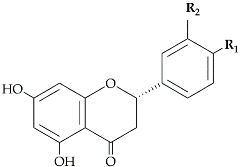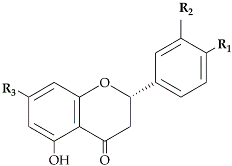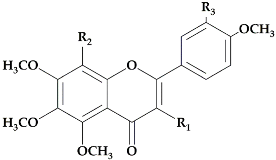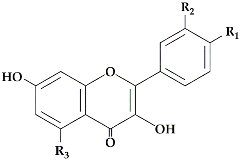Citrus species are one of the world’s popular fruit crops, cultivated all over the world for their economic and nutritional values. Citrus, like other fruits and vegetables, are an important source of several antioxidant molecules (polyphenols, ascorbic acid, and carotenoids) that can inhibit the harmful effects of free radicals on the human body; due to their functional values and health-promoting properties, Citrus species are considered valuable fruits not only in agri-food industry, but also in pharmaceutical industry. Flavonoids are among the major constituents of polyphenols found in different parts of Citrus fruits (skin, peels, seed, pulp membrane, and juice). Flavonoids have different biological properties (antiviral, antifungal, and antibacterial activities). Several studies have also shown the health-related properties of Citrus flavonoids, especially antioxidant, anticancer, anti-inflammation, anti-aging, and cardiovascular protection activities.
- Citrus genus
- bioactive molecules
- flavonoids
- therapeutic effects
- extraction methods
1. Introduction
2. Citrus Flavonoids: Structure, Classification and Biosynthesis
2.1. Structure and Classification of Flavonoids from Citrus
| Flavanones | Flavones | Total Flavonoids Content | |||||||||||||||||
|---|---|---|---|---|---|---|---|---|---|---|---|---|---|---|---|---|---|---|---|
| Hesperidin | Narirutin | Naringin | Didymin | Eriocitrin | Diosmin | 6,8-di-C-Glu-Diosmetin | 6,8-di-C-Glu-Apigenin | Sinensitin | |||||||||||
| Flavanones |  |
Hesperetin | R | 1 | = | O | -CH | 3 | |||||||||||
| Orange | 28.6 | 5.2 | - | 1.89 | 0.31 | 0.09 | 0.35 | 5.72 | 0.37 | 18.34 | |||||||||
| R | 2 | =OH | |||||||||||||||||
| Sour orange | - | - | 1.97 | - | - | 0.15 | - | - | - | - | Naringenin | R | 1 | =OH | |||||
| Mandarin orange | 24.3 | 3.92 | - | 1.44 | 0.31 | - | - | - | 1.05 | - | R | 2 | =H | ||||||
| Clementine | 39.9 | 4.64 | 0.08 | - | - | 1.25 | 0.2 | 0.5 | - | 19.23 | Flavanones glycosides |  |
Narirutin | R | 1 | = | O | -CH | 3 |
| Lemon | R | 2 | =H | ||||||||||||||||
| R | 3 | =7- | O | -rutinoside | |||||||||||||||
| 20.5 | Naringin | R | 1 | =OH | |||||||||||||||
| - | R | 2 | =H | ||||||||||||||||
| R | 3 | = | O | -7-Rhamnoglucoside | |||||||||||||||
| Flavones |  |
Apigenin | R | 1 | =OH | ||||||||||||||
| R | 2 | =R | 3 | =H | |||||||||||||||
| - | Luteolin | R | 1 | =R | 2 | =OH | |||||||||||||
| R | 3 | =H | |||||||||||||||||
| Polymethoxylated Flavones |  |
Nobiletin | R | 1 | =H | ||||||||||||||
| R | 2 | =R | 3 | =OCH | 3 | ||||||||||||||
| Tangeretin | R | 1 | =R | 3 | =H | ||||||||||||||
| R | 2 | =OCH | 3 | ||||||||||||||||
| Flavonols |  |
Quercetin | R | 1 | =R | 2 | =R | 3 | =OH | ||||||||||
| Kaempferol | R | 1 | =R | 3 | =OH | ||||||||||||||
| R | 2 | =H | |||||||||||||||||
2.2. Biosynthesis of Flavonoids

3. Flavonoid Composition in Different Parts of Citrus Fruits
It has been found that Citrus flavonoids are present in almost all the parts of Citrus fruits in different species. Several studies showed that peels are the main sources of polyphenols in Citrus fruits [19][15]. Seed and peel extracts from numerous Citrus species have proved to be an important source of flavonoids, such as polymethoxyflavones (PMFs), flavanones, and glycosylated flavanones [20][16]. More than 5000 flavonoid molecules have been identified [21][17]. Citrus juice is also a major source of flavanone glycosides. Moreover, the contents and types of flavonoids vary among different Citrus species and fruit parts [21][17]. Flavanones are the most important flavonoids in Citrus species. Hesperedin and naringenin are the predominant flavanones in Citrus fruits [16][12]. They can be found in all plant parts: stem, branches, bark, flowers, leaves, roots, rhizomes, seeds, fruits, peels, etc. Flavones are the second major group of flavonoids in Citrus, with flavonols in third place because their content is much lower than the other flavonoids [17,18][13][14]. The content of these components depends upon the age of the plant; most Citrus species accumulate substantial quantities of flavonoids during organ development. Another study showed that flavonoids content might be affected by the maturity of the fruit, the post-harvesting treatments and the extracting processes [22][18]. Juice preparation and the processing of fresh Citrus fruits may decrease flavonoids content by 50% due to their water washing methods [23[19][20],24], or by elimination of the richest parts of the fruit [25][21]. In this review, we gather some relevant data for the most abundant flavonoid component in sweet orange (C. sinensis), sour orange (C. aurantium), mandarin orange (C. reticulata), clementine (C. Clementina), lemon (C. limon), and grapefruit (C. Pardisi) juices and peel. It should be noted that Citrus peel exhibit higher contents of flavanones than other parts of the fruit [11][22]. Depending on their varieties, grapefruit and sour orange are very rich in naringin. Other Citrus species such as sweet orange, and lemon have low quantities of naringin (Table 32). Pupin et al. [26][23] studied the composition of flavanone glycosides in various orange juice varieties and concluded that narirutin and hesperidin are the most abundant compounds. Hesperidin is present in high levels in clementine, sweet orange, mandarin orange and lemon (39.9–20.5 mg/100 mL juice), while naringin (23 mg/100 mL juice) and narirutin (7.6 mg/100 mL juice), glycosides of naringenin, are especially more abundant in grapefruit (Table 32) [27][24]. In lemon, eriocitrin is present in high level (16.17 mg/100 mL juice) [26][23]. Didymin is a typical flavonoid glycoside also known as neoponcirin used in Asian countries as a dietary antioxidant [28][25]. This flavonoid is mainly present in orange, mandarin and grapefruit (1.89–0.30 mg/100 mL juice) (Table 32). The most abundant flavanones in Citrus peel are naringin andhesperidin. These flavanones are all glycosylated either by rutinose (6-O-α-l-rhamnosyl-d-glucose) or by neohesperidose (2-O-α-l-rhamnosyl-d-glucose) linked in position 7 [28][25]. Hesperidin (0.002 to 9.42 mg/g peel dry basis) [29,30][26][27] is the main flavanone in all lemon cultivars while levels of diosmin and eriocitrin are the lowest [31][28]. Mandarin peel is rich in hesperidin (3.95 to 80.90 mg/g peel dry basis) [32[29][30],33], narirutin (7.66 to 15.3 mg/g peel dry basis) [22[18][| - | ||||||||||
| 16.17 | ||||||||||
| 3.12 | ||||||||||
| 4.95 | 1.17 | - | - | |||||||
| Grapefruit | 0.93 | 7.60 | 23.0 | 0.3 | 0.41 | - | - | - | - | - |
4. Citrus Flavonoid Extraction Techniques
4.1. Conventional Extraction Techniques
4.2. Non-Conventional Extraction Techniques
4.2.1. Ultrasound Assisted Extraction (UAE)
4.2.2. Supercritical Fluid Extraction (SFE)
References
- Zhou, Z.Q. Citrus Fruits Nutrition; Science Press: Beijing, China, 2012.
- González-Molina, E.; Domínguez-Perles, R.; Moreno, D.A.; García-Viguera, C. Natural bioactive compounds of Citrus limon for food and health. J. Pharm. Biomed. Anal. 2010, 51, 327–345.
- Awad, M.A.; de Jager, A.; van der Plas, L.H.W.; van der Krol, A.R. Flavonoid and chlorogenic acid changes in skin of ‘Elstar’ and ‘Jonagold’apples during development and ripening. Sci. Hortic. 2001, 90, 69–83.
- Peterson, J.J.; Dwyer, J.T.; Beecher, G.R.; Bhagwat, S.A.; Gebhardt, S.E.; Haytowitz, D.B.; Holden, J.M. Flavanones in oranges, tangerines (mandarins), tangors, and tangelos: A compilation and review of the data from the analytical literature. J. Food Compos. Anal. 2006, 19, S66–S73.
- Li, B.B.; Smith, B.; Hossain, M.M. Extraction of phenolics from citrus peels: I. Solvent extraction method. Sep. Purif. Technol. 2006, 48, 182–188.
- Benavente-Garcia, O.; Castillo, J. Update on uses and properties of citrus flavonoids: New findings in anticancer, cardiovascular, and anti-inflammatory activity. J. Agric. Food Chem. 2008, 56, 6185–6205.
- Zou, Z.; Xi, W.; Hu, Y.; Nie, C.; Zhou, Z. Antioxidant activity of Citrus fruits. Food Chem. 2016, 196, 885–896.
- Ververidis, F.; Trantas, E.; Douglas, C.; Vollmer, G.; Kretzschmar, G.; Panopoulos, N. Biotechnology of flavonoids and other phenylpropanoid-derived natural products. Part I: Chemical diversity, impacts on plant biology and human health. Biotechnol. J. 2007, 2, 1214–1234.
- Vogt, T. Phenylpropanoid Biosynthesis. Mol. Plant. 2010, 3, 2–20.
- Austin, M.B.; Noel, J.P. The chalcone synthase superfamily of type III polyketide synthases. Nat. Prod. Rep. 2003, 20, 79–110.
- Tai, D.; Tian, J.; Zhang, J.; Song, T.; Yao, Y. A Malus crabapple chalcone synthase gene, McCHS, regulates red petal color and flavonoid biosynthesis. PLoS ONE. 2014, 9, e110570.
- Lewinsohn, E.; Britsch, L.; Mazur, Y.; Gressel, J. Flavanone glycoside biosynthesis in citrus: Chalcone synthase, UDP-glucose: Flavanone-7-O-glucosyl-transferase and-rhamnosyl-transferase activities in cell-free extracts. Plant Physiol. 1989, 91, 1323–1328.
- Li, Y.; Liu, X.; Cai, X.; Shan, X.; Gao, R.; Yang, S.; Han, T.; Wang, S.; Wang, L.; Gao, X. Dihydroflavonol 4-Reductase Genes from Freesia hybrida Play Important and Partially Overlapping Roles in the Biosynthesis of Flavonoids. Front. Plant Sci. 2017, 8, 428.
- Liu, C.; Wang, X.; Shulaev, V.; Dixon, R.A. A role for leucoanthocyanidin reductase in the extension of proanthocyanidins. Nat. Plants. 2016, 2, 1–7.
- Wang, L.; Wang, J.; Fang, L.; Zheng, Z.; Zhi, D.; Wang, S.; Li, S.; Ho, C.-T.; Zhao, H. Anticancer activities of citrus peel polymethoxyflavones related to angiogenesis and others. BioMed Res. Int. 2014, 2014, 453972.
- Xi, W.; Zhang, Y.; Sun, Y.; Shen, Y.; Ye, X.; Zhou, Z. Phenolic composition of Chinese wild mandarin (Citrus reticulata Balnco.) pulps and their antioxidant properties. Ind. Crops Prod. 2014, 52, 466–474.
- Harborne, J.B. The Flavonoids: Advances in Research Since 1980; Springer: Berlin/Heidelberg, Germany, 2013.
- Xu, G.; Ye, X.; Liu, D.; Ma, Y.; Chen, J. Composition and distribution of phenolic acids in Ponkan (Citrus poonensis Hort. ex Tanaka) and Huyou (Citrus paradisi Macf. Changshanhuyou) during maturity. J. Food Compos. Anal. 2008, 21, 382–389.
- Sánchez-Moreno, C.; Plaza, L.; Elez-Martínez, P.; De Ancos, B.; Martín-Belloso, O.; Cano, M.P. Impact of high pressure and pulsed electric fields on bioactive compounds and antioxidant activity of orange juice in comparison with traditional thermal processing. J. Agric. Food Chem. 2005, 53, 4403–4409.
- Polydera, A.C.; Stoforos, N.G.; Taoukis, P.S. Effect of high hydrostatic pressure treatment on post processing antioxidant activity of fresh Navel orange juice. Food Chem. 2005, 91, 495–503.
- Del Caro, A.; Piga, A.; Vacca, V.; Agabbio, M. Changes of flavonoids, vitamin C and antioxidant capacity in minimally processed citrus segments and juices during storage. Food Chem. 2004, 84, 99–105.
- Krueger, R.R.; Navarro, L. Citrus Germplasm Resources. In Citrus Genetics, Breeding and Biotechnology; CAB International: Wallingford, UK, 2007.
- Pupin, A.M.; Dennis, M.J.; Toledo, M.C.F. Flavanone glycosides in Brazilian orange juice. Food Chem. 1998, 61, 275–280.
- Tomás-Barberán, F.A.; Clifford, M.N. Dietary hydroxybenzoic acid derivatives–nature, occurrence and dietary burden. J. Sci. Food Agric. 2000, 80, 1024–1032.
- Yao, Q.; Lin, M.-T.; Zhu, Y.-D.; Xu, H.-L.; Zhao, Y.-Z. Recent trends in potential therapeutic applications of the dietary flavonoid didymin. Molecules 2018, 23, 2547.
- Wang, Y.-C.; Chuang, Y.-C.; Hsu, H.-W. The flavonoid, carotenoid and pectin content in peels of citrus cultivated in Taiwan. Food Chem. 2008, 106, 277–284.
- Russo, M.; Bonaccorsi, I.; Torre, G.; Sarò, M.; Dugo, P.; Mondello, L. Underestimated sources of flavonoids, limonoids and dietary fibre: Availability in lemon’s by-products. J. Funct. Foods. 2014, 9, 18–26.
- Del Río, J.A.; Fuster, M.D.; Gómez, P.; Porras, I.; Garcıa-Lidón, A.; Ortuño, A. Citrus limon: A source of flavonoids of pharmaceutical interest. Food Chem. 2004, 84, 457–461.
- Hayat, K.; Hussain, S.; Abbas, S.; Farooq, U.; Ding, B.; Xia, S.; Jia, C.; Zhang, X.; Xia, W. Optimized microwave-assisted extraction of phenolic acids from citrus mandarin peels and evaluation of antioxidant activity in vitro. Sep. Purif. Technol. 2009, 70, 63–70.
- Tumbas, V.T.; Ćetković, G.S.; Đilas, S.M.; Čanadanović-Brunet, J.M.; Vulić, J.J.; Knez, Ž.; Škerget, M. Antioxidant activity of mandarin (Citrus reticulata) peel. Acta Period. Technol. 2010, 195–203.
- Cheigh, C.-I.; Chung, E.-Y.; Chung, M.-S. Enhanced extraction of flavanones hesperidin and narirutin from Citrus unshiu peel using subcritical water. J. Food Eng. 2012, 110, 472–477.
- Giannuzzo, A.N.; Boggetti, H.J.; Nazareno, M.A.; Mishima, H.T. Supercritical fluid extraction of naringin from the peel of Citrus paradisi. Phytochem. Anal. 2003, 14, 221–223.
- Lee, Y.-H.; Charles, A.L.; Kung, H.-F.; Ho, C.-T.; Huang, T.-C. Extraction of nobiletin and tangeretin from Citrus depressa Hayata by supercritical carbon dioxide with ethanol as modifier. Ind. Crops Prod. 2010, 31, 59–64.
- Li, W.; Wang, Z.; Wang, Y.; Jiang, C.; Liu, Q.; Sun, Y.; Zheng, Y. Pressurised liquid extraction combining LC–DAD–ESI/MS analysis as an alternative method to extract three major flavones in Citrus reticulata ‘Chachi’ (Guangchenpi). Food Chem. 2012, 130, 1044–1049.
- Toledo-Guillén, A.R.; Higuera-Ciapara, I.; García-Navarrete, G.; De la Fuente, J.C. Extraction of Bioactive Flavonoid Compounds from Orange (Cit-rus sinensis) Peel Using Supercritical CO2. Atherosclerosis 2010, 178, 25–32.
- Zhang, J. Flavonoids in Grapefruit and commercial grapefruit juices: Concentration, distribution, and potential health benefi ts. Proc. Proc. Fla. State Hortic. Soc. 2007, 120, 288–294.
- Al-Anbari, A.K.H.; Hasan, M.A. Antioxidant activity in some citrus leaves and seeds ethanolic extracts. In Proceedings of the International Conference on Advances in Agricultural, Biological and Environmental Sciences (AABES), London, UK, 22–23 July 2015; pp. 22–23.
- Yu, J.; Dandekar, D.V.; Toledo, R.T.; Singh, R.K.; Patil, B.S. Supercritical fluid extraction of limonoids and naringin from grapefruit (Citrus paradisi Macf.) seeds. Food Chem. 2007, 105, 1026–1031.
- Tripoli, E.; La Guardia, M.; Giammanco, S.; Di Majo, D.; Giammanco, M. Citrus flavonoids: Molecular structure, biological activity and nutritional properties: A review. Food Chem. 2007, 104, 466–479.
- Peterson, J.J.; Beecher, G.R.; Bhagwat, S.A.; Dwyer, J.T.; Gebhardt, S.E.; Haytowitz, D.B.; Holden, J.M. Flavanones in grapefruit, lemons, and limes: A compilation and review of the data from the analytical literature. J. Food Compos. Anal. 2006, 19, S74–S80.
- Rao, M.J.; Wu, S.; Duan, M.; Wang, L. Antioxidant Metabolites in Primitive, Wild, and Cultivated Citrus and Their Role in Stress Tolerance. Molecules 2021, 26, 5801.
- Wang, S.; Yang, C.; Tu, H.; Zhou, J.; Liu, X.; Cheng, Y.; Luo, J.; Deng, X.; Zhang, H.; Xu, J. Characterization and Metabolic Diversity of Flavonoids in Citrus Species. Sci. Rep. 2017, 7, 10549.
- Ledesma-Escobar, C.A.; de Castro, M.D.L. Towards a comprehensive exploitation of citrus. Trends Food Sci. Technol. 2014, 39, 63–75.
- Smith, R.M. Before the injection—modern methods of sample preparation for separation techniques. J. Chromatogr. A 2003, 1000, 3–27.
- Azmir, J.; Zaidul, I.S.M.; Rahman, M.M.; Sharif, K.M.; Mohamed, A.; Sahena, F.; Jahurul, M.H.A.; Ghafoor, K.; Norulaini, N.A.N.; Omar, A.K.M. Techniques for extraction of bioactive compounds from plant materials: A review. J. Food Eng. 2013, 117, 426–436.
- Barba, F.J.; Putnik, P.; Bursać Kovačević, D.; Poojary, M.M.; Roohinejad, S.; Lorenzo, J.M.; Koubaa, M. Impact of conventional and non-conventional processing on prickly pear (Opuntia spp.) and their derived products: From preservation of beverages to valorization of by-products. Trends Food Sci. Technol. 2017, 67, 260–270.
- Pina-Pérez, M.C.; Rivas, A.; Martínez, A.; Rodrigo, D. Effect of thermal treatment, microwave, and pulsed electric field processing on the antimicrobial potential of açaí (Euterpe oleracea), stevia (Stevia rebaudiana Bertoni), and ginseng (Panax quinquefolius L.) extracts. Food Control. 2018, 90, 98–104.
- Ciulu, M.; Quirantes-Piné, R.; Spano, N.; Sanna, G.; Borrás-Linares, I.; Segura-Carretero, A. Evaluation of new extraction approaches to obtain phenolic compound-rich extracts from Stevia rebaudiana Bertoni leaves. Ind. Crops Prod. 2017, 108, 106–112.
- Uwineza, P.A.; Gramza-Michałowska, A.; Bryła, M.; Waśkiewicz, A. Antioxidant Activity and Bioactive Compounds of Lamium album Flower Extracts Obtained by Supercritical Fluid Extraction. Appl. Sci. 2021, 11, 7419.
- Kujundžić, D.; Jambrak, A.R.; Vukušić, T.; Stulić, V.; Kljusurić, J.G.; Banović, M.; Herceg, Z. Near-infrared spectroscopic characterization of steviol glycosides extracted from Stevia rebaudiana Bertoni using high-power ultrasound and gas-phase plasma. J. Food Nutr. Res. 2017, 56, 109–120.
- Barba, F.J.; Terefe, N.S.; Buckow, R.; Knorr, D.; Orlien, V. New opportunities and perspectives of high pressure treatment to improve health and safety attributes of foods. A review. Food Res. Int. 2015, 77, 725–742.
- Tamborrino, A.; Urbani, S.; Servili, M.; Romaniello, R.; Perone, C.; Leone, A. Pulsed electric fields for the treatment of olive pastes in the oil extraction process. Appl. Sci. 2020, 10, 114.
- Zuorro, A.; Lavecchia, R.; González-Delgado, Á.D.; García-Martinez, J.B.; L’Abbate, P. Optimization of enzyme-assisted extraction of flavonoids from corn husks. Processes 2019, 7, 804.
- Vongsak, B.; Sithisarn, P.; Mangmool, S.; Thongpraditchote, S.; Wongkrajang, Y.; Gritsanapan, W. Maximizing total phenolics, total flavonoids contents and antioxidant activity of Moringa oleifera leaf extract by the appropriate extraction method. Ind. Crops Prod. 2013, 44, 566–571.
- Ledesma-Escobar, C.A.; Priego-Capote, F.; Luque de Castro, M.D. Chapter 9—Relevance and Analysis of Citrus Flavonoids. In Polyphenols in Plants, 2nd ed.; Academic Press: Cambridge, MA, USA, 2019; pp. 133–150. ISBN 978-0-12-813768-0.
- Londoño-Londoño, J.; de Lima, V.R.; Lara, O.; Gil, A.; Pasa, T.B.C.; Arango, G.J.; Pineda, J.R.R. Clean recovery of antioxidant flavonoids from citrus peel: Optimizing an aqueous ultrasound-assisted extraction method. Food Chem. 2010, 119, 81–87.
- McHugh, M.; Krukonis, V. Supercritical Fluid Extraction: Principles and Practice; Elsevier: Amsterdam, The Netherlands, 2013; ISBN 0080518176.
- Machado, B.A.S.; Pereira, C.G.; Nunes, S.B.; Padilha, F.F.; Umsza-Guez, M.A. Supercritical fluid extraction using CO2: Main applications and future perspectives. Sep. Sci. Technol. 2013, 48, 2741–2760.
- Díaz-Reinoso, B.; Moure, A.; Domínguez, H.; Parajó, J.C. Supercritical CO2 Extraction and Purification of Compounds with Antioxidant Activity. J. Agric. Food Chem. 2006, 54, 2441–2469.
 Encyclopedia
Encyclopedia
